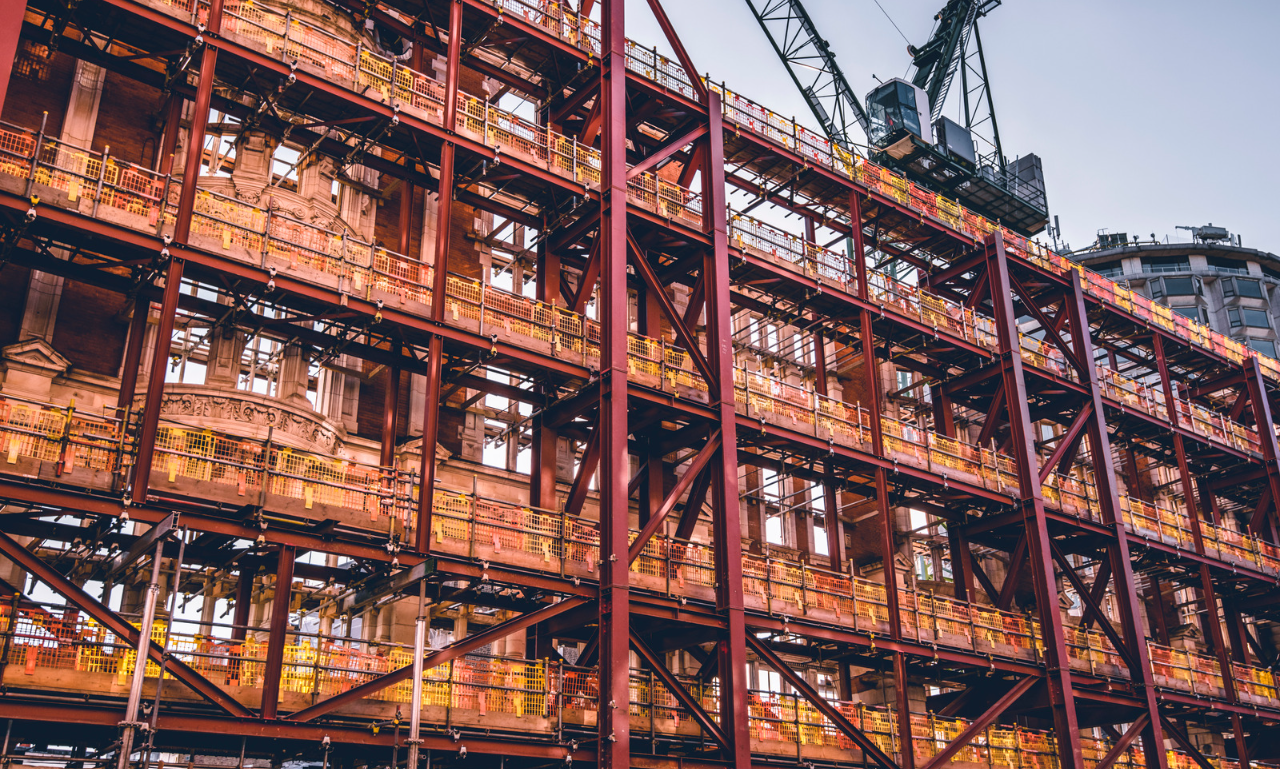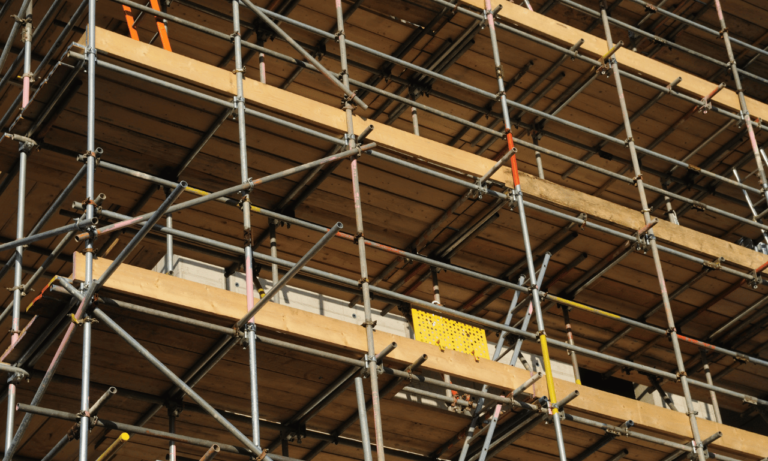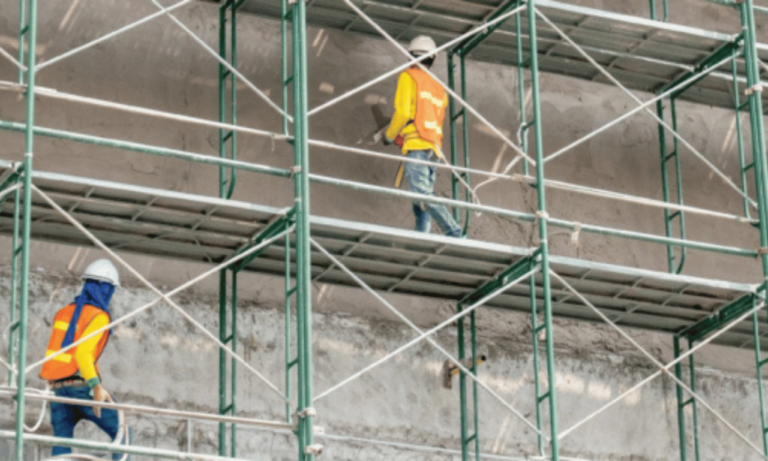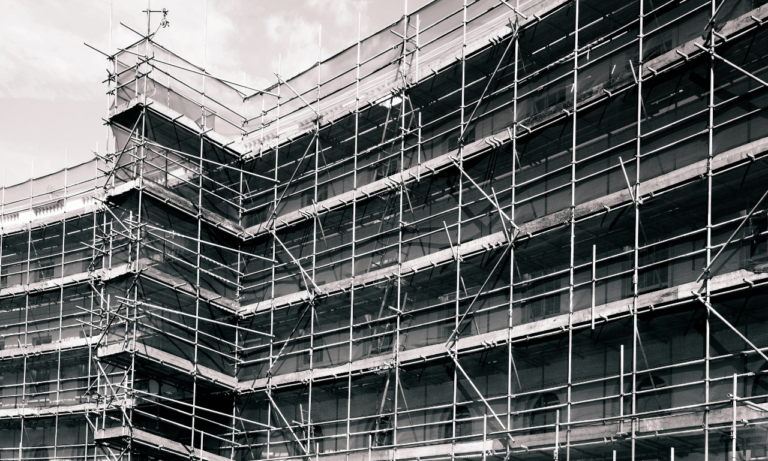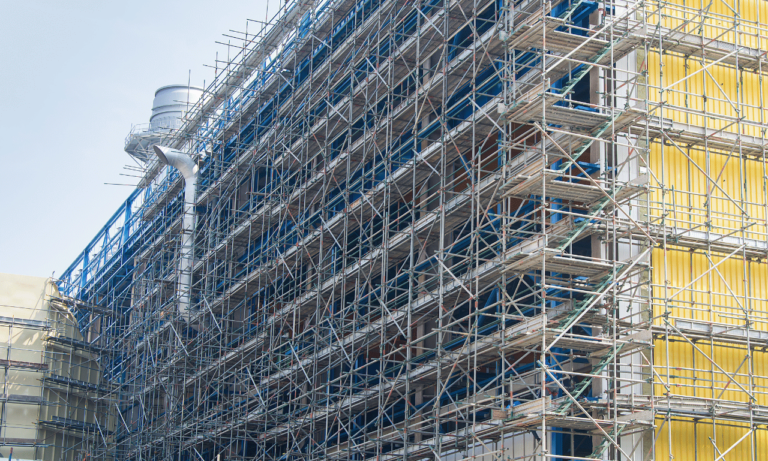Phone:
(+65)8319-0742
Facade retention scaffolding is a secure and reliable solution for building renovation projects. It provides support and structural reinforcement during the remodeling and modernization of building interiors while preserving the existing facade. This technique is often used to meet local planning or conservation requirements for retaining historical building facades. By using facade retention scaffolding, construction teams can create attractive living spaces and also support adjoining buildings or party walls. The choice between internal and external facade retention systems depends on the specific project requirements, with external systems being less intrusive and internal systems generally more cost-effective. There are various types of proprietary equipment, such as scaffolding and structural steel, that can be used for facade retention. Safety is of paramount importance, and proper design and monitoring are crucial to minimize the impact on local residents, traffic, and the environment.
Key Takeaways:
- Facade retention scaffolding provides support and structural reinforcement during building renovations.
- It allows for the preservation of existing facades while creating attractive living spaces.
- The choice between internal and external facade retention systems depends on project requirements.
- Various types of proprietary equipment, such as scaffolding and structural steel, can be used.
- Safety and proper design are essential for minimizing the impact on the environment and local residents.
Benefits of Facade Retention Scaffolding
Facade retention scaffolding offers several benefits for building renovation and facade maintenance projects. Firstly, it allows for the preservation of the existing facade, keeping the historical or architectural integrity of the building intact. This technique also provides temporary support, ensuring the safety and stability of the facade during the construction process. Facade retention scaffolding serves as a platform for facade maintenance, allowing workers to access and repair the facade without compromising its structural integrity.
Additionally, it can be used as a gantry for site offices and a loading platform for construction materials, reducing the need for additional equipment. With its flexible design and adaptability, facade retention scaffolding is a reliable solution for upgrading building facades.
Key Benefits of Facade Retention Scaffolding:
- Temporary Facade Support: Facade retention scaffolding provides temporary support, ensuring the stability of the facade during the construction process.
- Safety Scaffolding Solutions: By using facade retention scaffolding, safety is prioritized, reducing the risk of accidents and injuries.
- Facade Retention Technique: This technique allows for the preservation of historical or architectural facades, maintaining the visual appeal and character of the building.
- Facade Maintenance Platforms: It serves as a platform for facade maintenance, enabling workers to access and repair the facade without compromising its structural integrity.
Design Considerations for Facade Retention
When designing facade retention scaffolding, several design challenges must be taken into consideration. These challenges ensure that the temporary works align with the project’s objectives and do not clash with the new construction and demolition processes.
One of the key considerations is choosing between internal or external facade retention systems. External systems are less disruptive to the overall construction process and offer additional advantages, such as serving as gantries or loading platforms. These systems are particularly beneficial when there is limited space inside the building for temporary works. On the other hand, internal systems can often be more cost-effective and are easily braced against internal walls. They require fewer temporary foundations, which can be advantageous in projects with space or budget constraints.
Design Challenges
– **Spatial Requirements**: Determining the space available for facade retention works and selecting the appropriate system accordingly.
– **Structural Compatibility**: Ensuring that the temporary works do not interfere with the new construction or clash with the existing structure.
– **Weight Considerations**: Evaluating the weight-bearing capacity of the building and the facade retention system to ensure stability and safety.
– **Aesthetic Impact**: Minimizing the visible impact of the facade retention system on the building’s exterior appearance.
– **Integration with Other Temporary Works**: Coordinating the design of the facade retention system with other temporary works, such as access scaffolding or hoisting equipment.
Choosing the right design approach depends on the specific requirements and limitations of each project. It is crucial to analyze the project’s objectives, spatial constraints, and budget to determine the most suitable facade retention system.
Internal vs. External Systems
| Pros of Internal Systems | Pros of External Systems |
|—————————————————|————————————————–|
| – Cost-effective | – Less disruptive to the overall construction |
| – Easily braced against internal walls | – Can serve as gantries or loading platforms |
| – Requires fewer temporary foundations | – Provides additional space for temporary works |
It is essential to weigh the benefits of each system against the project’s specific requirements to make an informed decision.
The design considerations for facade retention scaffolding involve addressing various challenges and choosing between internal and external systems. By carefully evaluating the project’s needs and constraints, construction teams can ensure the successful implementation of temporary works and the preservation of the building’s facade.
Equipment for Facade Retention
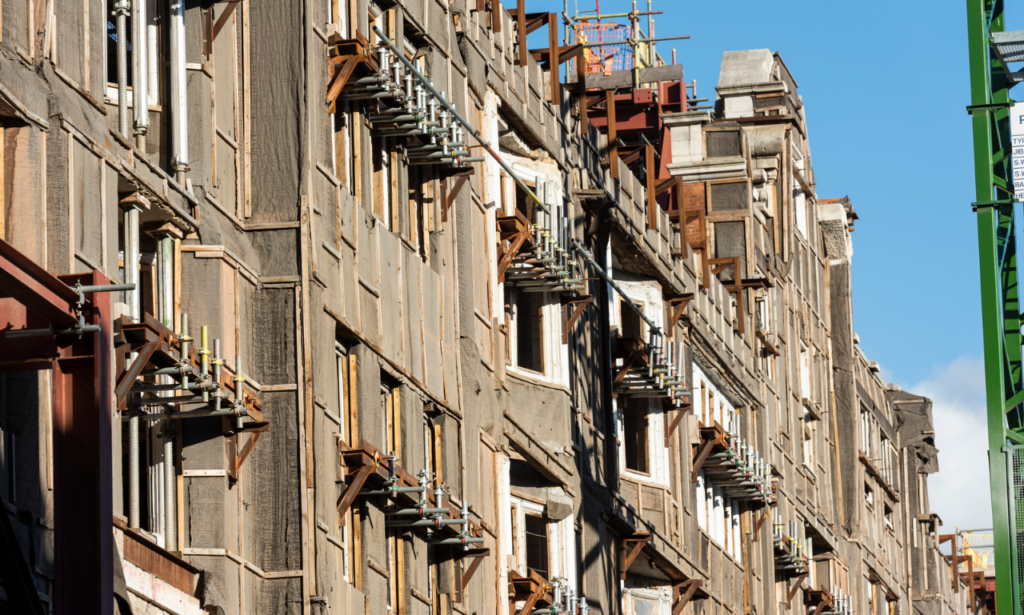
When it comes to facade retention, selecting the most suitable equipment is essential for the success of the project. Various types of proprietary equipment can be utilized to ensure a secure and reliable facade retention system. Two primary examples are scaffolding and structural steel, which offer flexibility and customization options to meet the specific requirements of each project.
Scaffolding plays a crucial role in facade retention, providing a temporary support system during building renovation. It offers stability and safety for construction teams working on the project. With the ability to be customized and adapted, scaffolding can be designed to fit different building shapes and sizes, ensuring a precise fit and optimal support.
Structural steel is another key component of facade retention systems. It adds strength and stability to the structure, contributing to the overall durability and longevity of the retained facade. By utilizing high-quality structural steel, construction teams can ensure that the facade can withstand the required loads and environmental factors.
Working with a team of experts in facade retention is crucial for a successful project. These teams often include monitoring and jacking specialists who oversee the proper installation and maintenance of the facade retention system. They ensure that the equipment is correctly positioned, monitored, and adjusted if necessary, minimizing the risk of any structural or safety issues.
In addition, having access to a fabrication workshop can greatly enhance the efficiency of the facade retention process. These workshops enable the customization and fabrication of specific components, ensuring that the equipment fits perfectly and meets the project’s unique specifications. This allows for greater precision and quality control, contributing to the overall success of the project.
Overall, the selection and use of suitable facade retention equipment, such as scaffolding and structural steel, in collaboration with monitoring and jacking teams and a fabrication workshop, are fundamental to the safe and effective execution of facade retention projects.
| Benefits of Suitable Facade Retention Equipment |
|---|
| Ensures secure and reliable support for retained facades |
| Allows for customization and adaptation to specific project requirements |
| Provides stability and safety for construction teams |
| Enhances the durability and longevity of the retained facade |
| Facilitates precise fitting and optimal support for different building shapes and sizes |
| Enables monitoring and adjustments to ensure structural integrity |
| Allows for customization and fabrication of components for greater precision |
| Improves overall efficiency and quality control |
Case Studies: Facade Retention in Liverpool
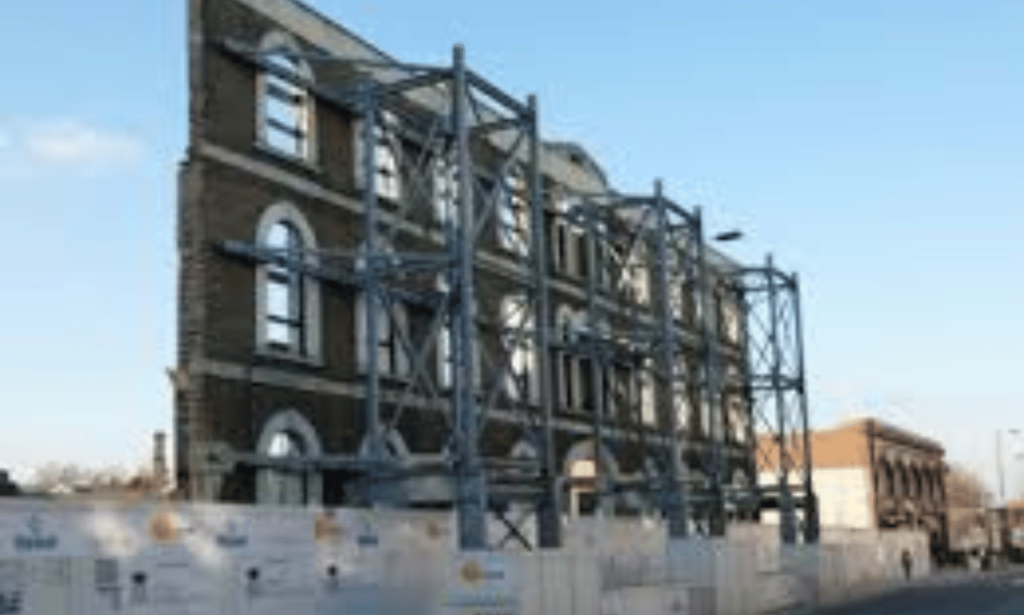
Liverpool, known for its rich architectural heritage, has successfully utilized facade retention techniques to preserve its historic buildings. Many of these structures faced decay and neglect, presenting significant challenges that required innovative solutions to save even the facades.
The Liverpool city council took its responsibility seriously and sought external funding and support from government agencies and heritage organizations to tackle this issue. Several case studies in Liverpool serve as evidence of the effectiveness of facade retention in preserving the city’s architectural treasures.
One notable case involved a Grade II listed Georgian terrace on Seel Street. This historic building was in a state of disrepair, with unstable party walls and debris posing safety hazards. However, through the installation of a facade retention system, the terrace’s facade was successfully retained, allowing for the safe removal of debris and stabilization of the structure. This project exemplifies the importance of facade retention in preserving the architectural character of Liverpool’s listed buildings.
Another case study highlights the restoration of a Regency brick house on Shaw Street. Despite facing significant structural decay, the facade of this historic house was successfully retained using facade retention techniques. This achievement not only preserved the building’s architectural integrity but also contributed to the overall preservation of Liverpool’s heritage.
Facade Retention Case Studies in Liverpool
| Building | Location | Condition | Facade Retention Technique |
|---|---|---|---|
| Grade II listed Georgian terrace | Seel Street | In disrepair with unstable party walls and debris | Facade retention system |
| Regency brick house | Shaw Street | Significant structural decay | Facade retention techniques |
The case studies in Liverpool demonstrate the effectiveness of facade retention techniques in preserving the city’s architectural heritage. These projects not only save the facades of historic buildings but also contribute to the revitalization and sustainability of the community.
The Importance of Facade Retention

Facade retention is a critical technique for preserving the architectural heritage and character of buildings. It allows for the safe restoration and renovation of structures while maintaining the original facade. By retaining the facade, buildings can be adapted for modern uses without compromising their historical and aesthetic value.
This technique is particularly important in areas with significant cultural or historical significance, where the preservation of the built environment is crucial. It ensures that the unique architectural features and design elements are preserved for future generations to appreciate and enjoy. Building preservation plays a vital role in maintaining a connection to our past, enriching our understanding of history, and fostering a sense of identity and place.
Heritage conservation is not just about preserving the physical aspects of a building, but also about preserving intangible values and stories associated with it. It allows us to understand the evolution of our society, the communities that have shaped it, and the architectural trends that have influenced its progress.
When we prioritize building preservation and heritage conservation, we are making a commitment to maintaining architectural integrity. This means not only preserving the external appearance of a building but also ensuring that its structural elements are sound and well-maintained. By doing so, we contribute to the sustainability of our built environment and protect our cultural and historical assets.
Community Support and Engagement
Facade retention projects often receive support from local communities, as they recognize the value of preserving their architectural heritage. Community involvement is crucial in fostering a sense of ownership and shared responsibility for the preservation of historic buildings.
Communities can actively participate in heritage conservation efforts through advocacy, fundraising, and educational initiatives. They can work alongside preservation organizations, local authorities, and professionals to develop strategies for the sustainable preservation of their built heritage.
Furthermore, by preserving historic buildings, communities can enhance their cultural identity, promote tourism, and stimulate economic growth. These buildings often become significant landmarks and focal points within their neighborhoods, attracting visitors and generating business opportunities.
Overall, the support and engagement of the community are essential in ensuring the long-term success of facade retention projects and the preservation of our architectural heritage. By working together, we can protect and celebrate our shared history and create a sustainable and vibrant future for our communities.
| Fact | Importance |
|---|---|
| Preserves architectural heritage | Ensures the historical and aesthetic value of buildings is maintained |
| Strengthens community identity | Preserving historic buildings contributes to a sense of place and community |
| Stimulates economic growth | Historic buildings attract tourism and create business opportunities |
| Protects tangible and intangible heritage | Preserving buildings helps safeguard stories and cultural values |
| Promotes sustainability | Maintaining architectural integrity contributes to a sustainable built environment |
Conclusion
Facade retention scaffolding serves as a secure and reliable support system for building renovation projects. Its use ensures the preservation of historical facades, safeguarding the integrity and character of the structures. Whether opting for internal or external facade retention techniques, this approach provides a multitude of benefits, including temporary support, safety scaffolding solutions, and facade maintenance platforms.
The success of facade retention projects hinges upon meticulous design considerations and the selection of appropriate equipment. By prioritizing these factors, construction teams can effectively reinforce buildings and create a safe working environment. The case studies in Liverpool stand as testament to the efficacy of facade retention systems, showcasing their ability to preserve and restore historic structures.
Facade retention plays a pivotal role in building preservation and heritage conservation. Through its application, communities can revitalize and sustain their architectural treasures. By utilizing building renovation support and implementing structural reinforcement systems like facade retention scaffolding, we ensure the lasting legacy of our built environment for generations to come.
FAQ
What is facade retention scaffolding?
Facade retention scaffolding is a secure and reliable solution for building renovation projects. It provides support and structural reinforcement during the remodeling and modernization of building interiors while preserving the existing facade.
Why is facade retention scaffolding used?
Facade retention scaffolding is often used to meet local planning or conservation requirements for retaining historical building facades. It also supports adjoining buildings or party walls and creates attractive living spaces.
What are the benefits of using facade retention scaffolding?
Facade retention scaffolding allows for the preservation of the existing facade, provides temporary support during construction, serves as a platform for facade maintenance, and can be used as a gantry and loading platform for construction materials.
What factors should be considered when designing facade retention scaffolding?
The method of new construction and demolition, the choice between internal or external systems, and the specific design challenges posed by the project should be considered when designing facade retention scaffolding.
What equipment can be used for facade retention?
Various types of proprietary equipment, such as scaffolding and structural steel, can be used for facade retention. Working with a team that has expertise in facade retention, including monitoring and jacking teams, is crucial for proper installation and maintenance.
How has facade retention been utilized in Liverpool?
Facade retention techniques have been successfully used in Liverpool to preserve the city’s historic buildings. The city council has secured funding and support from government agencies and heritage organizations to save and restore facades on listed buildings.
Why is facade retention important?
Facade retention is important for preserving the architectural heritage and character of buildings, adapting structures for modern uses, and contributing to the overall revitalization and sustainability of communities.

